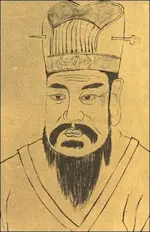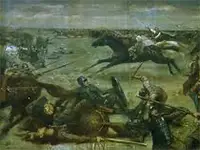Emperor Wang Mang of China
Wang Mang was the one and only emperor in China's Xin Dynasty, ruling for 14 years in the first millennium A.D. Originally viewed as a hero and a reformer, he ended his life as a disappointment to his people. 
He was born into the royal family, as the son of Wang Man, whose sister was the powerful Grand Empress Dowager Wang. He embraced the teachings of Confucius at an early age and embraced the Confucian ideas of thrift and humility. His uncle Wang Feng was commander of the armed forces and secured his nephew's appointment as subcommander of the imperial guard. Another uncle, Wang Shang, rewarded his young nephew with a title and a new imperial post. The money that he Wang Mang received from the title and roles he gave to help others study the teachings of Confucius. Yet another uncle, Wang Gen, was the powerful head of the armed forces and, when he died, in 8 B.C., named Wang Mang as his successor. This was the time of the Han Dynasty in China. The following year, Emperor Cheng died and was replaced by Emperor Ai, who proved to be very unpopular with the rest of the ruling family. Ai had a brief rule, reigning only six years. He was dominated by his grandmother, the Grand Empress Dowager Fu, who, when Ai died, refused to recognize his successor, his trusted advisor Dong Xian, and instead declared the emperor's cousin Jizi the new ruler; he became Emperor Ping. The new emperor was only 8 and depended on others to run things. By this time, Wang Mang had also married his daughter to the young Emperor Ping. Wang Mang was much trusted by the royal family and accepted the offer to become Emperor Ping's regent. Because of the recent spate of childless emperors, people inside the royal court and out suspected that the Han rulers had lost the Mandate of Heaven. Wang Mang acted in several ways to counteract this impression. He brought in scholars to reside at the court and increased the money being paid to royal officials. A turnaround in harvests in A.D. 3 helped buoy public opinion as well. At the same time, Wang Mang consolidated his hold on power by alienating the young emperor from his family, including killing some of them. A power struggle ensued, and the regent came out on top, having poisoned the 13-year-old emperor in A.D. 5. Wang Mang served as acting emperor for three years, overseeing the technical rule of Liu Ying (also known as Ruzi Ying) and then took the throne for himself. Wang Mang declared a new dynasty, the Xin, and made his wife empress. They had four sons and made the younger, Wang Lin, crown prince. Continuing with recent trends, the new emperor populated his court with Confucian scholars. One of the new emperor's first major initiatives was a large land redistribution system. In effect, the emperor owned all land in the empire. Technically, landowners still had control of the property; but if they had property that the emperor deemed larger than they should have, they had to give it away. The emperor also abolished slavery, which had been part of the economic system of China since its beginnings. Further consolidating the state's hold on production, the emperor assumed control of a number of things, including fishing, forestry, and the production of liquor, salt, and weapons. He took things further the following year, introducing a tax that penalized landowners who didn't keep up their land or refused to work; anyone who couldn't pay the resulting fine would have to work for the state in order to pay off the debt. Most revolutionary of all, Wang Mang brought in an income tax of 10 percent. Some of these things proved unpopular but didn't worry the emperor enough to make a change. He did have to backtrack on the abolition of slavery and the land redistribution system. Another change that didn't go well at all was the introduction of a new coinage system that featured 28 different coins–made of copper, gold, silver, sea shells, and tortoise shells; the system proved so confusing that the emperor reduced the number of coins to two. One thing that Wang Mang proved unable to stem was a rise in corruption. State officials siphoned off a significant amount of royal revenue, and the emperor lost favor with his people because of the perceived lack of control. Another misstep for the emperor was in his treatment of the traditional enemy the Xiongnu, a group of tribes who lived to the north and west of China. They had harassed previous emperors for many years, and they and Chinese armies traded invasions and victories that resulted in varying stages of peace, warfare, and confusion. Wang Mang took advantage of a succession controversy in Xiongnu in A.D. 18 and forced the people there to accept his choice as ruler. The result was an outbreak of hostilities. In China itself, a combination of bad harvests and at times oppressive economic policies fomented a number of rebellions, first and foremost in rural areas. A major famine resulting from massive flooding in the Yellow River delta in A.D. 11 contributed mightily to this unrest. 
One of the leaders of these rebellions, Liu Yan, claimed a distant connection to the Han dynasty, which bolstered his reputation among those who were disappointed with the emperor and his policies. Liu Yan took up arms with a large number of those disaffected and took control of a growing amount of territory. His brother Liu Xiu joined in this crusade, and the two gained many followers. The restyled Han army declared one of its other leaders, Liu Xuan, also of Han descent, as the new emperor, named Gengshi. He named Liu Yan as his head of government. Wang Mang refused to accept this declaration of a new ruler and, in A.D. 23, sent a large army to confront the Han army. After a number of skirmishes, the Han army gained the upper hand and stormed the imperial palace. After a fierce battle, the Han army defeated Wang Mang's personal guard and then killed the emperor. Liu Xuan, as Gengshi, proclaimed a new Han dynasty. |
|
Social Studies for Kids
copyright 2002–2025
David White




